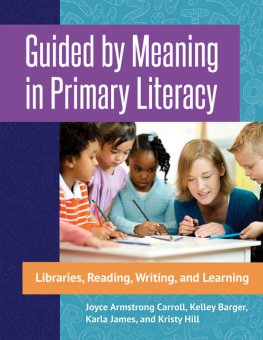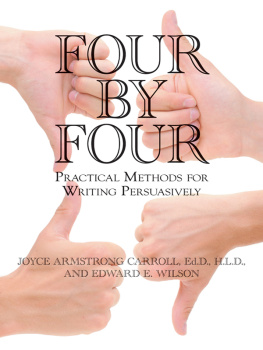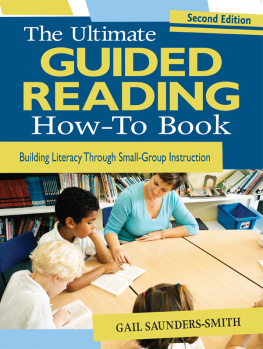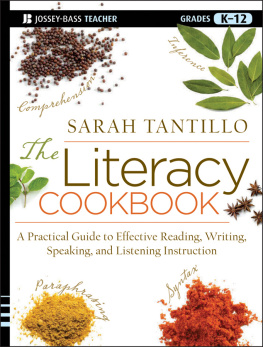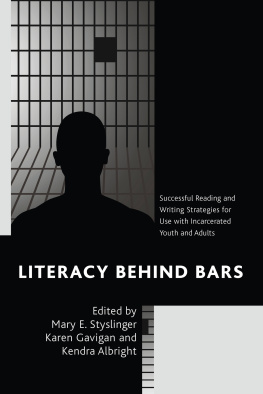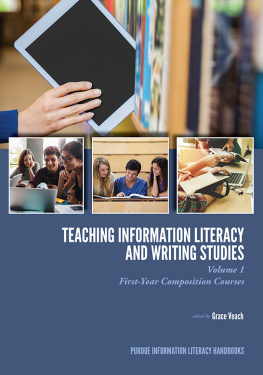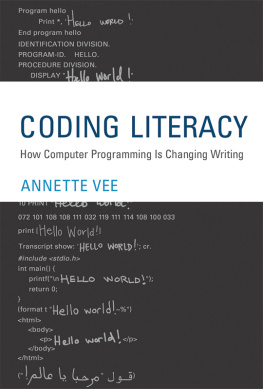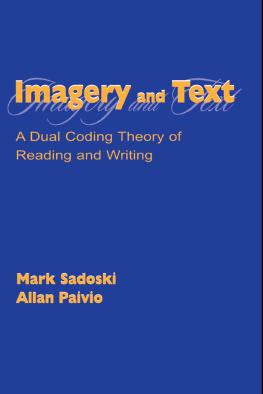Guided by Meaning in Primary Literacy
Guided by Meaning
in Primary Literacy
Libraries, Reading, Writing, and Learning
Joyce Armstrong Carroll, Kelley Barger,
Karla James, and Kristy Hill

Copyright 2017 Joyce Armstrong Carroll, Kelley Barger, Karla James, and Kristy Hill
All rights reserved. No part of this publication may be reproduced, stored in a retrieval system, or transmitted, in any form or by any means, electronic, mechanical, photocopying, recording, or otherwise, except for the inclusion of brief quotations in a review, without prior permission in writing from the publisher.
Library of Congress Cataloging-in-Publication Control Number: 2016036397
ISBN: 978-1-4408-4398-3
EISBN: 978-1-4408-4399-0
21 20 19 18 17 1 2 3 4 5
This book is also available as an eBook.
Libraries Unlimited
An Imprint of ABC-CLIO, LLC
ABC-CLIO, LLC
130 Cremona Drive, P.O. Box 1911
Santa Barbara, California 93116-1911
www.abc-clio.com
This book is printed on acid-free paper 
Manufactured in the United States of America
A childs behavior is always guided by meaning.
Lev Vygotsky
To all the eager young learners who populate our schools.
JAC
To the students, faculty, and staff of Beneke Elementary for being a vibrant, creative, and inspiring place to teach and learn. Thank-you Cindi, Debbie, and Sarah for years of collaboration in and out of our kindergarten classrooms.
KB
To Leyton, Ethan, and Tristan for being my best writing students, and for all of the kids at ERES who enjoy writing in the library!
KH
To my family, Prentice, P. J., and Christian, who inspire me to live life with meaning. To the students and staff at E. C. Mason, who share my passion for writing.
KJ
Contents
Foreword
First Day of School
Here, take my child.
He has a fistful of crayons,
Is ready to begin
To enter the halls that smell of chalk dust and lemon oil.
He wants to colour a picture.
Help him to see that the colour he chooses,
The pictures he makes, are beautiful
Before you ask him to paint the Sistine Chapel.
Here, take my child.
She knows one and one makes two.
I want her to learn to add,
Without being subtracted from.
I want her to multiply her abilities,
But not if it divides her against herself.
Here, take my child.
He has a book he wants to read.
Let him read it first,
Tell you why he likes it,
Before you ask him to read a book
You think he should read
To be up to the level.
Here, take my child.
She has written a poem:
dandy lions are golden buttons in the grass
Smell those dandelions, see the image,
Before you tell her dandelions are weeds or
Dandelions is not spelled correctly.
Here, take my child
but TAKE CARE.
Sheree Fitch
A few years ago, I was invited to be the visiting author for a beautiful new elementary school in South Carolina. As I drove up, I noticed the marquee that proudly announced that this school had been named a Blue Ribbon Campus, meaning that the test scores for this group of children had consistently been on the higher end of the spectrum.
I could tell, before I even got to the front door, that this was a school that had been carefully tended. The grounds were clean and orderly, the playground was large and sunny, and there was a grove of friendly trees lining the back fence. It was obviously a well-cared-for neighborhood school, one to which from all appearances any parents would love to send their children. I was happy to be there.
Walking through the doors was no different, at least at first. The halls were painted with lively primary colors, and they were shiny clean. In the office, I was greeted by the school librarian and escorted to the cafeteria where I would talk to the kidsone grade level at a timeabout my life as a writer, something Ive been doing for so many years now, I cant count them. As I set up my laptop and adjusted the projector, the children began to file in and sit in rows on the floor. They were orderly, clearly used to coming to the cafeteria for presentations. As they plopped down, one by one, the librarian gently prodded them, Crisscross-applesauce.
Oh how I love crisscross-applesauce. For me, its a signal that stories are about to happen. Its code for snuggle up, my homies, and listen. Whenever I hear it, my heartbeat picks up, and I am suddenly the luckiest person in the world to be with these children, in this beautiful school, in the midst of Story, with a capital S. The lights in the room went down, and we were off.
Like I always do, I started my presentations by reminding everyone that wewe humans, that isare the only ones in the animal kingdom, so far as we know, who tell stories. We know that other animals communicate, that they give signals and mark trees and sing and whatnot. But so far as we know, they do not gather at the base of the elm trees and discuss the state of the world or what their mothers fed them for dinner the night before. Armadillos arent in the habit of regaling other armadillos about the anthills they have conquered, and flamingos dont remind their chicks about how they flew 2,000 miles to visit their flamingo relatives. At least as far as we can tell.
So we are the story animals, the ones who share our lives through stories. And this, I remind them, is what makes our stories so darned important. Stories are what separate us from the other animals. Theyre what make us most human and they have the added benefit of making us most humane as well. Our holiest books are compendia of stories that have been with us for thousands of years.
In fact, stories, I told my young audience, are so sacred and so powerful that we actually go to war over whose stories are best. A tragic misuse of story, for sure, because they also have the power of bringing us together, something theyve done for centuries. The caves of Lacaux, which Dr. Carroll describes so eloquently in these pages, are one example of that ancient, most basic human act, telling stories.
In that darkened school cafeteria in South Carolina, the stately trees just outside the door, I talked to those 200 children, all crisscross-applesauced, and invited them to come along with me as I shared some of my stories, and I encouraged them to think about their own stories as we went along. It was all good.
However, somewhere in the middle of my second or third presentation, I realized that these well-mannered, orderly students only peripherally seemed to engage with me. They were polite, no question. They laughed at the right moments. They asked plenty of questions. But despite so much rightness, there was something reserved about these small story animals. Too reserved.
I began to feel itchy, as if there were something I had missed. What was I doing wrong? It just seemed that something was off. But I couldnt seem to put my finger on it, especially considering the situation: a lovely, well-situated Blue Ribbon Campus, in a solid middle-class neighborhood, where everything seemed to be in place.
At the end of the day, I thanked the librarian, packed up my laptop, and made my way to the front door. Normally, after a day like this, I leave feeling exhausted, but in a happy way. That day, I just felt exhausted. Nothing had gone wrong, but that itch wouldnt go away.
And then, somewhere between the cafeteria and the door, walking down the hallway with its merry primary tones, so cheerful and bright, I figured it all out. I saw what was missing. There was not a single piece of student work on display. No art. No writing. No bits and pieces of student-generated stories. Nothing but clean, empty color.
Next page
